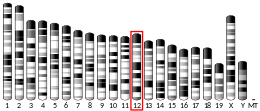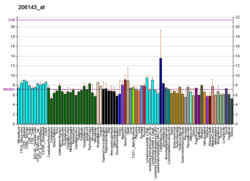Chloride anion exchanger
Chloride anion exchanger, also known as down-regulated in adenoma (protein DRA), is a protein that in humans is encoded by the SLC26A3 gene.[5]
Function
Protein DRA is a membrane protein in intestinal cells. It is an anion exchanger and a member of the sulfate anion transporter (SAT) family. It mediates chloride and bicarbonate exchange and additionally transports sulfate and other anions at the apical membrane, part of the plasma membrane of enterocytes. It is different from the anion exchanger that present in erythrocytes, renal tubule, and several other tissues.[6]
The protein encoded by this gene is a transmembrane glycoprotein that functions as a sulfate transporter. It is localized to the mucosa of the lower intestinal tract, particularly to the apical membrane of columnar epithelium and some goblet cells, and is instrumental in chloride reuptake, aiding in the creation of an osmotic gradient for resorption of fluid from the lumen of the intestine.[7]
Clinical significance
Mutations in this gene have been associated with congenital chloride diarrhoea,[5] a treatable disease.
The congenital absence of this membrane protein results in an autosomal recessive disorder called congenital chloridorrhea or congenital chloride diarrhea (CLD).[8]
See also
References
- GRCh38: Ensembl release 89: ENSG00000091138 - Ensembl, May 2017
- GRCm38: Ensembl release 89: ENSMUSG00000001225 - Ensembl, May 2017
- "Human PubMed Reference:". National Center for Biotechnology Information, U.S. National Library of Medicine.
- "Mouse PubMed Reference:". National Center for Biotechnology Information, U.S. National Library of Medicine.
- "Entrez Gene: SLC26A3 solute carrier family 26, member 3".
- Sterling D, Brown NJ, Supuran CT, Casey JR (November 2002). "The functional and physical relationship between the DRA bicarbonate transporter and carbonic anhydrase II". American Journal of Physiology. Cell Physiology. 283 (5): C1522-9. doi:10.1152/ajpcell.00115.2002. PMID 12372813.
- Singla A, Kumar A, Priyamvada S, Tahniyath M, Saksena S, Gill RK, Alrefai WA, Dudeja PK (March 2012). "LPA stimulates intestinal DRA gene transcription via LPA2 receptor, PI3K/AKT, and c-Fos-dependent pathway". American Journal of Physiology. Gastrointestinal and Liver Physiology. 302 (6): G618-27. doi:10.1152/ajpgi.00172.2011. PMC 3311307. PMID 22159277.
- Alrefai WA, Wen X, Jiang W, Katz JP, Steinbrecher KA, Cohen MB, Williams IR, Dudeja PK, Wu GD (November 2007). "Molecular cloning and promoter analysis of downregulated in adenoma (DRA)". American Journal of Physiology. Gastrointestinal and Liver Physiology. 293 (5): G923-34. doi:10.1152/ajpgi.00029.2007. PMID 17761837.
Further reading
- Sandal NN, Marcker KA (January 1994). "Similarities between a soybean nodulin, Neurospora crassa sulphate permease II and a putative human tumour suppressor". Trends in Biochemical Sciences. 19 (1): 19. doi:10.1016/0968-0004(94)90168-6. PMID 8140616.
- Markovich D (October 2001). "Physiological roles and regulation of mammalian sulfate transporters". Physiological Reviews. 81 (4): 1499–533. doi:10.1152/physrev.2001.81.4.1499. PMID 11581495.
- Mäkelä S, Kere J, Holmberg C, Höglund P (December 2002). "SLC26A3 mutations in congenital chloride diarrhea". Human Mutation. 20 (6): 425–38. doi:10.1002/humu.10139. PMID 12442266.
- Schweinfest CW, Henderson KW, Suster S, Kondoh N, Papas TS (May 1993). "Identification of a colon mucosa gene that is down-regulated in colon adenomas and adenocarcinomas". Proceedings of the National Academy of Sciences of the United States of America. 90 (9): 4166–70. doi:10.1073/pnas.90.9.4166. PMC 46467. PMID 7683425.
- Taguchi T, Testa JR, Papas TS, Schweinfest C (March 1994). "Localization of a candidate colon tumor-suppressor gene (DRA) to 7q22-q31.1 by fluorescence in situ hybridization". Genomics. 20 (1): 146–7. doi:10.1006/geno.1994.1148. PMID 8020951.
- Höglund P, Haila S, Socha J, Tomaszewski L, Saarialho-Kere U, Karjalainen-Lindsberg ML, Airola K, Holmberg C, de la Chapelle A, Kere J (November 1996). "Mutations of the Down-regulated in adenoma (DRA) gene cause congenital chloride diarrhoea". Nature Genetics. 14 (3): 316–9. doi:10.1038/ng1196-316. PMID 8896562.
- Byeon MK, Frankel A, Papas TS, Henderson KW, Schweinfest CW (February 1998). "Human DRA functions as a sulfate transporter in Sf9 insect cells". Protein Expression and Purification. 12 (1): 67–74. doi:10.1006/prep.1997.0809. PMID 9473459.
- Höglund P, Haila S, Gustavson KH, Taipale M, Hannula K, Popinska K, Holmberg C, Socha J, de la Chapelle A, Kere J (1998). "Clustering of private mutations in the congenital chloride diarrhea/down-regulated in adenoma gene". Human Mutation. 11 (4): 321–7. doi:10.1002/(SICI)1098-1004(1998)11:4<321::AID-HUMU10>3.0.CO;2-A. PMID 9554749.
- Antalis TM, Reeder JA, Gotley DC, Byeon MK, Walsh MD, Henderson KW, Papas TS, Schweinfest CW (August 1998). "Down-regulation of the down-regulated in adenoma (DRA) gene correlates with colon tumor progression". Clinical Cancer Research. 4 (8): 1857–63. PMID 9717812.
- Höglund P, Auranen M, Socha J, Popinska K, Nazer H, Rajaram U, Al Sanie A, Al-Ghanim M, Holmberg C, de la Chapelle A, Kere J (September 1998). "Genetic background of congenital chloride diarrhea in high-incidence populations: Finland, Poland, and Saudi Arabia and Kuwait". American Journal of Human Genetics. 63 (3): 760–8. doi:10.1086/301998. PMC 1377387. PMID 9718329.
- Lohi H, Kujala M, Kerkelä E, Saarialho-Kere U, Kestilä M, Kere J (November 2000). "Mapping of five new putative anion transporter genes in human and characterization of SLC26A6, a candidate gene for pancreatic anion exchanger". Genomics. 70 (1): 102–12. doi:10.1006/geno.2000.6355. PMID 11087667.
- Höglund P, Sormaala M, Haila S, Socha J, Rajaram U, Scheurlen W, Sinaasappel M, de Jonge H, Holmberg C, Yoshikawa H, Kere J (September 2001). "Identification of seven novel mutations including the first two genomic rearrangements in SLC26A3 mutated in congenital chloride diarrhea". Human Mutation. 18 (3): 233–42. doi:10.1002/humu.1179. PMID 11524734.
- Lohi H, Kujala M, Makela S, Lehtonen E, Kestila M, Saarialho-Kere U, Markovich D, Kere J (April 2002). "Functional characterization of three novel tissue-specific anion exchangers SLC26A7, -A8, and -A9". The Journal of Biological Chemistry. 277 (16): 14246–54. doi:10.1074/jbc.M111802200. PMID 11834742.
- Lamprecht G, Heil A, Baisch S, Lin-Wu E, Yun CC, Kalbacher H, Gregor M, Seidler U (October 2002). "The down regulated in adenoma (dra) gene product binds to the second PDZ domain of the NHE3 kinase A regulatory protein (E3KARP), potentially linking intestinal Cl-/HCO3- exchange to Na+/H+ exchange". Biochemistry. 41 (41): 12336–42. doi:10.1021/bi0259103. PMID 12369822.
- Chernova MN, Jiang L, Shmukler BE, Schweinfest CW, Blanco P, Freedman SD, Stewart AK, Alper SL (May 2003). "Acute regulation of the SLC26A3 congenital chloride diarrhoea anion exchanger (DRA) expressed in Xenopus oocytes". The Journal of Physiology. 549 (Pt 1): 3–19. doi:10.1113/jphysiol.2003.039818. PMC 2342915. PMID 12651923.
This article incorporates text from the United States National Library of Medicine, which is in the public domain.




